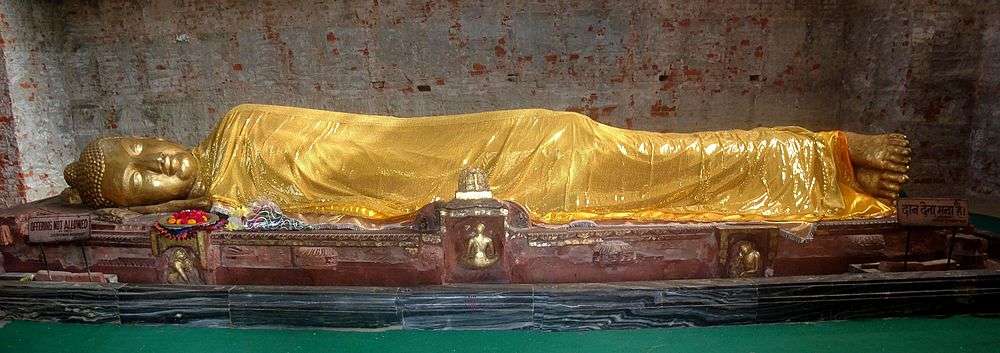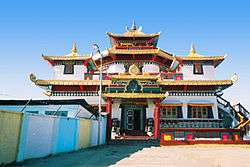Buddhist pilgrimage sites in India

In religion and spirituality, a pilgrimage is a long journey or search of great moral significance. Sometimes, it is a journey to a sacred place or shrine of importance to a person's beliefs and faith. Members of every major religion participate in pilgrimages. A person who makes such a journey is called a pilgrim.
There are number of historical Buddhist pilgrimage sites in India.
Primary sites
| Pilgrimage to |
| Buddha's Holy Sites |
|---|
 |
| The Four Main Sites |
| Four Additional Sites |
| Other Sites |
| Later Sites |
Buddhism offers four major sites of pilgrimage: the Buddha's birthplace at Lumbini, the site where he attained Enlightenment Bodh Gaya, where he first preached at Benaras, and where he achieved Parinirvana at Kusinagara. Some Buddhist pilgrimage sites in India are listed below:
- Bodh Gaya, Bihar - The site of the enlightenment of Gautama Buddha.
- Sarnath, outside Varanasi, Uttar Pradesh - The site of the first sermon.
- Kushinagar, Uttar Pradesh - the site of the Buddha's paranibbana.
These are three of the four holiest sites in Buddhism. The fourth, Lumbini, the birthplace of the Buddha, is now in southern Nepal.
 "Maha Bodhi Temple" at Bodh Gaya
"Maha Bodhi Temple" at Bodh Gaya
 Ancient Buddhist Monastery at Sarnath
Ancient Buddhist Monastery at Sarnath
 Remains of ancient stupas in Kushinagar
Remains of ancient stupas in Kushinagar

Buddhist pilgrimage sites in India
- Patna, Bihar - Formerly known as Pataliputra, it was the seat of the Mauryan empire and a significant Buddhist centre
- Rajgir, Bihar - Formerly known as Rajagaha, it was the capital of Magadha, ruled by King Bimbisara, one of the most prominent monarchs and supporters during the lifetime of the Buddha
- Nalanda, Bihar - Site of an ancient Buddhist university, destroyed by Bakhtiyar Khalji during Islamic attacks
- Sravasti, Uttar Pradesh - Formerly known as Savatthi, it was the capital of Kosala, ruled by King Pasenadi, one of the most prominent monarchs and supporters during the lifetime of the Buddha
- Vaishali, Bihar - Seat of a republican state of the Lichchavis, prominent supporters of the Buddha. Site of the Second Buddhist Council
The name of Bihar is derived from vihara, meaning monastery, such was the association of the area with Buddhism. In addition to these sites which were visited by the Buddha, other sites in India have become notable
- Sanchi, Madhya Pradesh - Site of a large stupa built by Ashoka, it also stored the relics of Sariputra and Mahamoggallana, the two chief disciples of the Buddha; reputedly the place from which Mahinda set out to proselytise Sri Lanka.
- Ajanta and Ellora, Maharashtra - the site of intricate cave paintings depicting Buddhism
- Nagarjunakonda, Bavikonda, Thotlakonda, Salihundam, Amaravati, Andhra Pradesh, Ratnagiri, Odisha, Lalitgiri, Odisha and Udayagiri, Odisha - former sites of Buddhist education
There are a proliferation of Tibetan Buddhist sites in India
- Tawang, Arunachal Pradesh
- Rumtek, Sikkim
- Dharamsala, Himachal Pradesh
- Tabo Monastery
- Leh, Ladakh
- Namdroling Monastery, Bylakuppe, Near Mysore, Karnataka
Further sites
- Bojjannakonda, Andhra Pradesh
- Bhattiprolu, Andhra Pradesh
- Bagh Caves, Madhya Pradesh
- Chandavaram, Andhra Pradesh
- Guntupalli, Andhra Pradesh
- Ghantasala, Andhra Pradesh
- Harwan, near Srinagar, Kashmir
- Nelakondapalli,[1] Telangana
- Pavurallakonda,[1] Andhra Pradesh
- Phanigiri, Telangana
- Panderathan, Kashmir
- Parihaspura, Jammu and Kashmir
- Ramatheertham, Andhra Pradesh
- Vadnagar, Mehsana District, Gujarat[2]
- McLeod Ganj, Dharamsala, Himachal Pradesh
- Namphake, Dibrugarh, Assam
- Surya Pahar, Goalpara, Assam
- Hayagriva Madhava, Hajo, Assam
Monasteries
Pemayangtse Monastery
The Pemayangtse Monastery is a Buddhist monastery in Pemayangtse, near Pelling in the northeastern Indian state of Sikkim, located 140 kilometres (87 mi) west of Gangtok.[3]
Tawang Monastery
Tawang Monastery in the Indian state of Arunachal Pradesh is the largest monastery in India and second largest in the world after the Potala Palace in Lhasa, Tibet.
Zang Dhok Palri Phodang
Zang Dhok Palri Phodang is a Buddhist monastery in Kalimpong in West Bengal, India. The monastery is located atop Durpin Hill, one of the two hills of the town. It was consecrated in 1976 by the visiting Dalai Lama.
Rumtek Monastery
Rumtek Monastery also called the "Dharmachakra Centre", is a gompa located in the Indian state of Sikkim near the capital Gangtok. It is a focal point for the sectarian tensions within the Karma Kagyu school of Tibetan Buddhism that characterize the Karmapa controversy.
Enchey Monastery
Enchey Monastery is located in Gangtok, the capital city of Sikkim in the Northeastern Indian state. It belongs to the Nyingma order of Vajrayana Buddhism.
Tashiding Monastery
Tashiding Monastery is a Buddhist monastery of the Nyingma sect of Tibetan Buddhism in Western Sikkim, northeastern India. It is located on top of the hill rising between the Rathong chu and the Rangeet River.
Dubdi Monastery
Dubdi Monastery, occasionally called 'Yuksom Monastery' is a Buddhist monastery of the Nyingma sect of Tibetan Buddhism near Yuksom, in the Geyzing subdivision of West Sikkim district.[4][5]
Ralang Monastery
Ralang Monastery is a Buddhist monastery of the Kagyu sect of Tibetan Buddhism in southern Sikkim, northeastern India. It is located six kilometres from Ravangla.[6]
 The Manadala at the "Kakaling", the entry gate to the Tawang Monastery.
The Manadala at the "Kakaling", the entry gate to the Tawang Monastery.
 The Zang Dhok Palri Phodang monastery atop Durpin Hill.
The Zang Dhok Palri Phodang monastery atop Durpin Hill.- Prayer Wheels in the Rumtek Monastery.
 Ornately carved colourful Window of Enchey Monastery.
Ornately carved colourful Window of Enchey Monastery.
 The Golden Chorten near Tashiding Monastery.
The Golden Chorten near Tashiding Monastery.

See also
References
- 1 2 "Archived copy". Archived from the original on 2012-02-09. Retrieved 2012-10-24.
- ↑ New Buddha site found in Gujarat
- ↑ "Pemayangtse Monastery". Buddhist Tourism. Retrieved November 7, 2009.
- ↑ "Monasteries". sikkiminfo.in. Retrieved November 21, 2009.
- ↑ "Monasteries in Sikkim are of three types". Dubdi Monastery. Sikkim Info. Retrieved 2010-05-05.
- ↑ "Ralang Monastery". Buddhist-temples.com. Retrieved November 21, 2009.
| Wikimedia Commons has media related to Buddhist pilgrimage sites in India. |
External links
- Web
- Videos
- Youtube: Lord Buddha & Buddhist Pilgrimage Sites in India —A Documentary in Hindi